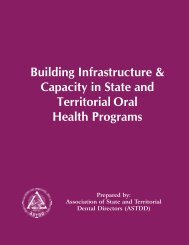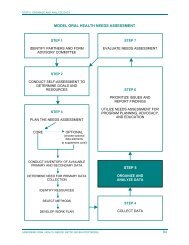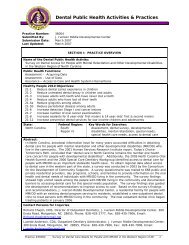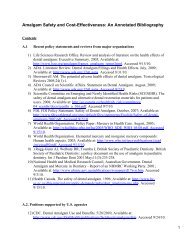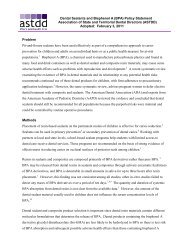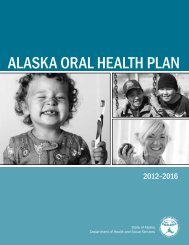Worksheet #1 â Forming an Advisory Committee - Association of ...
Worksheet #1 â Forming an Advisory Committee - Association of ...
Worksheet #1 â Forming an Advisory Committee - Association of ...
You also want an ePaper? Increase the reach of your titles
YUMPU automatically turns print PDFs into web optimized ePapers that Google loves.
WORKSHEETS<br />
<strong>Worksheet</strong> <strong>#1</strong> – <strong>Forming</strong> <strong>an</strong> <strong>Advisory</strong> <strong>Committee</strong>: Potential <strong>Committee</strong> Members<br />
<strong>Advisory</strong><br />
Potential Org<strong>an</strong>izations<br />
& Agencies<br />
<strong>Committee</strong> Person Email Address Telephone/Fax<br />
(Y/N)<br />
Oral Health<br />
State or Local Dental<br />
<strong>Association</strong> (Americ<strong>an</strong>/National)<br />
Americ<strong>an</strong> Academy <strong>of</strong><br />
Pediatric Dentistry, state<br />
chapter<br />
State or Local Dental<br />
Hygienists’ <strong>Association</strong><br />
Schools <strong>of</strong> Dentistry<br />
Schools <strong>of</strong> Dental<br />
Hygiene<br />
Other State or Local<br />
Agency Dental Personnel<br />
(e.g., mental health,<br />
corrections, tribal)<br />
Education Programs<br />
School <strong>of</strong> Public Health,<br />
Public Policy (or<br />
equivalent)<br />
Other State/Local Programs<br />
State Maternal <strong>an</strong>d Child<br />
Health (Title V)<br />
State Children with<br />
Special Health Care<br />
Needs (CSHCN)<br />
Early <strong>an</strong>d Periodic<br />
Screening, Diagnosis <strong>an</strong>d<br />
Treatment (EPDST)<br />
Medicaid <strong>an</strong>d SCHIP<br />
Program<br />
Women, Inf<strong>an</strong>ts, <strong>an</strong>d<br />
Children (WIC) Program<br />
Epidemiology<br />
ASSESSING ORAL HEALTH NEEDS: ASTDD SEVEN-STEP MODEL
WORKSHEETS<br />
<strong>Worksheet</strong> <strong>#1</strong> – Continued<br />
Potential Org<strong>an</strong>izations<br />
& Agencies<br />
<strong>Advisory</strong><br />
<strong>Committee</strong><br />
(Y/N)<br />
Person Email Address Telephone/Fax<br />
Other State/Local Programs (continued)<br />
Health Promotion/<br />
Health Education<br />
Department <strong>of</strong> Education/School<br />
Administration<br />
Head Start <strong>Association</strong>/Gr<strong>an</strong>tees<br />
Special Population<br />
Org<strong>an</strong>izations (e.g.,<br />
homeless, developmental<br />
disabilities, rural)<br />
Primary Care <strong>Association</strong><br />
(Community/ Migr<strong>an</strong>t<br />
Health Centers<br />
Local Health Officers /<br />
MCH Directors<br />
Allied Health <strong>Association</strong>s / Institutions<br />
State or Local Medical<br />
<strong>Association</strong> / Academy <strong>of</strong><br />
Pediatrics<br />
State Public Health<br />
<strong>Association</strong><br />
Hospitals (Children’s)<br />
Other<br />
Advocacy Org<strong>an</strong>izations<br />
Federal Agency Representatives<br />
(e.g., Regional<br />
field <strong>of</strong>fices )<br />
ASSESSING ORAL HEALTH NEEDS: ASTDD SEVEN-STEP MODEL
WORKSHEETS<br />
<strong>Worksheet</strong> #2 – Needs Assessment Goals<br />
TO WHAT EXTENT DO YOU HOPE TO ACCOMPLISH EACH OF THE FOLLOWING<br />
THROUGH YOUR NEEDS ASSESSMENT (circle the most appropriate number for each item)<br />
NOT AT ALL MODERATE HIGH<br />
Fulfill the requirements <strong>of</strong> the MCH Block Gr<strong>an</strong>t 1 2 3 4 5<br />
Network with other programs / agencies / org<strong>an</strong>izations 1 2 3 4 5<br />
Build a constituency for oral health issues 1 2 3 4 5<br />
Establish baseline data 1 2 3 4 5<br />
Update existing data 1 2 3 4 5<br />
Prioritize programs 1 2 3 4 5<br />
Justify budget (mainten<strong>an</strong>ce / exp<strong>an</strong>sion / reallocation) 1 2 3 4 5<br />
Increase visibility <strong>of</strong> program in agency 1 2 3 4 5<br />
Target resources to specific populations 1 2 3 4 5<br />
Fulfill expectations <strong>of</strong> administration / legislature 1 2 3 4 5<br />
Monitor compli<strong>an</strong>ce with legal requirements 1 2 3 4 5<br />
Publish findings in pr<strong>of</strong>essional journal(s) 1 2 3 4 5<br />
Educate decision makers 1 2 3 4 5<br />
Collect data in a timely fashion 1 2 3 4 5<br />
Collect valid (accurate) / reliable (reproducible) data 1 2 3 4 5<br />
Generalize findings to target population 1 2 3 4 5<br />
Evaluate existing programs 1 2 3 4 5<br />
Other<br />
1 2 3 4 5<br />
1 2 3 4 5<br />
ASSESSING ORAL HEALTH NEEDS: ASTDD SEVEN-STEP MODEL
WORKSHEETS<br />
INSTRUCTIONS FOR COMPLETING<br />
WORKSHEET #3<br />
As discussed on pages 17-19 <strong>of</strong> the m<strong>an</strong>ual,<br />
<strong>Worksheet</strong> 3 is designed to help you<br />
choose which methods <strong>of</strong> data collection<br />
you will use for the core <strong>an</strong>d optional data<br />
items you (<strong>an</strong>d your advisory committee)<br />
have chosen.<br />
<strong>Worksheet</strong> 3 consists <strong>of</strong> five pages, this<br />
instruction page plus four pages with the<br />
data items <strong>an</strong>d corresponding data collection<br />
methods (one for the core items <strong>an</strong>d<br />
three for the optional items). The three<br />
pages with the data items <strong>an</strong>d data collection<br />
methods are formatted for 17” X 11”<br />
paper. You c<strong>an</strong> print them on smaller paper<br />
by selecting “Scale to Paper Size” from your<br />
print menu.<br />
On the worksheet, there are 37 data items<br />
listed in the left column. Each item is<br />
followed by a rationale for collecting the<br />
data. Across the top <strong>of</strong> the worksheet,<br />
lettered A – I, are the nine data collection<br />
methods in increasing order <strong>of</strong> resources<br />
required, from left to right. The nine methods<br />
are grouped into four color-coded<br />
categories: secondary data (blue); programmatic<br />
data (yellow); community input<br />
(green); <strong>an</strong>d basic screening survey (gold).<br />
chosen, <strong>an</strong>d then determine which data<br />
collection method(s) you will use for each <strong>of</strong><br />
them. Mark the “box” in the appropriate<br />
lightly shaded cell. The “box” in each data<br />
collection cell is a text box <strong>an</strong>d you c<strong>an</strong><br />
electronically add <strong>an</strong> X to <strong>an</strong>y box you<br />
choose.<br />
On the fourth matrix, add other optional data<br />
items you have chosen, <strong>an</strong>d then determine<br />
which data collection method(s) you will<br />
use.<br />
KEY<br />
Data Item / Method Code<br />
pp 40<br />
2A<br />
A detailed description <strong>of</strong> how<br />
to collect data using method A<br />
begins on page 40 (Step 4).<br />
Every lightly shaded cell on <strong>Worksheet</strong> 3 is<br />
labeled with a unique number-letter combination<br />
(e.g. 6B, 11G). The number-letter<br />
combinations are called data item / method<br />
combinations. Each labeled cell contains<br />
the page in STEP 4 where the instructions<br />
on how to collect particular data begin.<br />
On the first matrix, choose which methods<br />
you will use to collect data for each <strong>of</strong> the<br />
core items (<strong>#1</strong>-11) by marking the “box” in<br />
the appropriate lightly shaded cell. The<br />
“box” in each data collection cell is a text<br />
box <strong>an</strong>d you c<strong>an</strong> electronically add <strong>an</strong> X to<br />
<strong>an</strong>y box you choose.<br />
On the second, third, <strong>an</strong>d fourth matrix,<br />
place a check in the column next to the<br />
optional data items (<strong>#1</strong>2-37) you have<br />
ASSESSING ORAL HEALTH NEEDS: ASTDD SEVEN-STEP MODEL
WORKSHEET #3 – CORE: DEVELOPING THE NEEDS ASSESSMENT PLAN<br />
METHODS FOR DATA COLLECTION<br />
A B C D E F G H I<br />
Secondary Other Secondary<br />
Data (e.g., Indicators Program Data Program Data Comment Groups<br />
Demographic Nonclinical Clinical<br />
Public Inform<strong>an</strong>t<br />
MATRIX 1<br />
Data from<br />
National Oral Medicaid, EPA, (e.g., Census,<br />
(e.g. patient<br />
DATA ITEMS/TYPES OF INFORMATION<br />
Health Surveys Board <strong>of</strong> Board <strong>of</strong><br />
records)<br />
(e.g.,<br />
NHANES)<br />
Dentistry) Education)<br />
CORE INFORMATION RATIONALE FOR COLLECTING INFORMATION The lightly shaded boxes represent acceptable methods for data collection. Place <strong>an</strong> X in the text box for the method that you chose.<br />
Questionnaire/<br />
Interview<br />
Survey<br />
Basic Screening<br />
Survey<br />
1<br />
DEMOGRAPHICS<br />
description <strong>of</strong> population<br />
(e.g., age, race, SES, school enrollment)<br />
To provide perspective about the underlying population.<br />
Useful when targeting populations for oral health programs;<br />
serves as a denominator in developing population estimates.<br />
pp 46<br />
1B<br />
pp 55<br />
1C<br />
2<br />
ORAL HEALTH STATUS<br />
% <strong>of</strong> children with untreated decay<br />
To indicate the degree <strong>of</strong> access to, <strong>an</strong>d utilization <strong>of</strong>, dental<br />
treatment services.<br />
pp 40<br />
2A<br />
pp 61<br />
2E<br />
pp 73<br />
2H<br />
pp 80<br />
2I<br />
3<br />
% <strong>of</strong> children who have dental caries<br />
experience<br />
To describe the overall caries prevalence <strong>an</strong>d indicate the<br />
degree <strong>of</strong> need for preventive programs.<br />
pp 40<br />
3A<br />
pp 61<br />
3E<br />
pp 73<br />
3H<br />
pp 80<br />
3I<br />
4<br />
RISK REDUCTION<br />
% <strong>of</strong> people served by community water<br />
systems with optimally fluoridated water<br />
To indicate the need for community water fluoridation, a<br />
cornerstone for dental public health programs. Information<br />
also is useful in targeting school-based <strong>an</strong>d individualized<br />
fluoride strategies.<br />
pp 46<br />
4B<br />
5<br />
% <strong>of</strong> children with seal<strong>an</strong>t on 1+ perm<strong>an</strong>ent<br />
molar teeth<br />
To indicate the degree <strong>of</strong> access to, <strong>an</strong>d dentist utilization<br />
<strong>of</strong>, <strong>an</strong> import<strong>an</strong>t caries preventive method. Seal<strong>an</strong>ts prevent<br />
caries on the most susceptible tooth surfaces.<br />
pp 40<br />
5A<br />
pp 46<br />
5B<br />
pp 56<br />
5D<br />
pp 61<br />
5E<br />
pp 73<br />
5H<br />
pp 80<br />
5I<br />
6<br />
SYSTEMS DEVELOPMENT / ACCESS<br />
# <strong>of</strong> dental providers in a state (by county<br />
or other division)<br />
To indicate the number <strong>of</strong> general dentists <strong>an</strong>d dental<br />
specialists. In combination with population data, this will<br />
provide <strong>an</strong> initial indicator <strong>of</strong> dentally underserved areas.<br />
pp 46<br />
6B<br />
7<br />
dentist participation in Medicaid program<br />
(number participating <strong>an</strong>d level <strong>of</strong> participation)<br />
To indicate availability <strong>of</strong> dental care services through the<br />
largest public fin<strong>an</strong>cing system <strong>of</strong> dental care for a vulnerable<br />
population, lower SES families.<br />
pp 46<br />
7B<br />
pp 73<br />
7H<br />
8<br />
# (%) <strong>of</strong> children under age 19 years at or<br />
below 200% <strong>of</strong> FPL who receive preventive<br />
dental services<br />
To indicate the degree <strong>of</strong> access to, <strong>an</strong>d utilization <strong>of</strong>,<br />
different types <strong>of</strong> dental care services through the largest<br />
public fin<strong>an</strong>cing system <strong>of</strong> dental care for a vulnerable<br />
population, lower SES children.<br />
pp 46<br />
8B<br />
9<br />
description <strong>of</strong> public resources for dental<br />
care (e.g., C/MHCs, local health departments,<br />
dental school clinics)<br />
To describe the public system <strong>of</strong> preventive <strong>an</strong>d primary<br />
dental care services. An underst<strong>an</strong>ding <strong>of</strong> all resources is <strong>an</strong><br />
import<strong>an</strong>t first step in developing systems <strong>of</strong> primary oral<br />
health care services.<br />
pp 46<br />
9B<br />
pp 61<br />
9E<br />
pp 73<br />
9H<br />
10<br />
% <strong>of</strong> children that have visited a dentist<br />
during the previous year<br />
To assess the effectiveness <strong>of</strong> a potential mech<strong>an</strong>ism for: 1)<br />
identifying children who have not entered the primary dental<br />
care system, <strong>an</strong>d 2) linking them with a source <strong>of</strong> care at <strong>an</strong><br />
early age.<br />
pp 46<br />
10B<br />
pp 56<br />
10D<br />
pp 73<br />
10H<br />
11<br />
perceived oral health needs <strong>of</strong> consumers<br />
<strong>an</strong>d their assessment <strong>of</strong> accessibility,<br />
acceptability <strong>an</strong>d affordability <strong>of</strong> oral<br />
health care received.<br />
To provide perspective on the extent to which services meet<br />
the population’s perceived needs. This information is critical<br />
to the development <strong>of</strong> family-centered system <strong>of</strong> primary<br />
care.<br />
pp 46<br />
11B<br />
pp 66<br />
11F<br />
pp 69<br />
11G<br />
pp 73<br />
11H
WORKSHEET #3 – OPTIONAL: DEVELOPING THE NEEDS ASSESSMENT PLAN<br />
12<br />
OPTIONAL INFORMATION<br />
Review the items <strong>an</strong>d check the box to the right<br />
<strong>of</strong> each item that you w<strong>an</strong>t to include.<br />
DEMOGRAPHICS<br />
# (%) <strong>of</strong> children below ____% <strong>of</strong> poverty<br />
who are uninsured (or underinsured) for<br />
oral health services<br />
MATRIX 2<br />
DATA ITEMS/TYPES OF INFORMATION<br />
a<br />
RATIONALE FOR COLLECTING<br />
OPTIONAL INFORMATION<br />
To help underst<strong>an</strong>d the extent to which children have<br />
fin<strong>an</strong>cial access to the oral health care system.<br />
METHODS FOR DATA COLLECTION<br />
A B C D E F G H I<br />
Secondary<br />
Data from<br />
National Oral<br />
Health Surveys<br />
(e.g.,<br />
NHANES)<br />
Other Secondary<br />
Data (e.g.,<br />
Medicaid, EPA,<br />
Board <strong>of</strong><br />
Dentistry)<br />
Demographic<br />
Indicators<br />
(e.g., Census,<br />
Board <strong>of</strong><br />
Education)<br />
Nonclinical<br />
Program Data<br />
Clinical<br />
Program Data<br />
(e.g. patient<br />
records)<br />
Public<br />
Comment<br />
Inform<strong>an</strong>t<br />
Groups<br />
The lightly shaded boxes represent acceptable methods for data collection. Place <strong>an</strong> X in the text box for the method that you chose.<br />
pp 46<br />
12B<br />
Questionnaire/<br />
Interview<br />
Survey<br />
pp 73<br />
12H<br />
Basic Screening<br />
Survey<br />
13<br />
# (%) <strong>of</strong> preschool children in: 1) Head<br />
Start program, <strong>an</strong>d 2) other day care<br />
programs<br />
To assess the potential number <strong>of</strong> children who would<br />
be reached by oral health education <strong>an</strong>d treatment<br />
programs targeted at the preschool population.<br />
pp 46<br />
13B<br />
14<br />
ORAL HEALTH STATUS<br />
% <strong>of</strong> children needing dental treatment<br />
according to urgency <strong>of</strong> need<br />
To indicate the severity <strong>of</strong> carious lesions in children’s<br />
teeth.<br />
pp 40<br />
14A<br />
pp 61<br />
14E<br />
pp 80<br />
14I<br />
15 % <strong>of</strong> children with oral injuries<br />
To indicate the number <strong>of</strong> oral injuries that occur in<br />
children.<br />
pp 40<br />
15A<br />
pp 61<br />
15E<br />
pp 73<br />
15H<br />
pp 80<br />
15I<br />
16 % <strong>of</strong> children with dental fluorosis<br />
To estimate the extent to which children are ingesting<br />
greater th<strong>an</strong> optimal amount <strong>of</strong> fluoride. May indicate<br />
the need for education <strong>of</strong> primary care providers about<br />
fluoride prescription habits.<br />
pp 40<br />
16A<br />
pp 61<br />
16E<br />
pp 80<br />
16I<br />
17<br />
% <strong>of</strong> adults (women <strong>of</strong> childbearing age)<br />
with gingivitis <strong>an</strong>d/or destructive periodontal<br />
disease<br />
To indicate the need for periodontal preventive <strong>an</strong>d<br />
treatment services for adults <strong>an</strong>d women <strong>of</strong> childbearing<br />
age.<br />
pp 40<br />
17A<br />
pp 61<br />
17E<br />
pp 80<br />
17I<br />
18<br />
% <strong>of</strong> adults who have had a tooth<br />
extracted because <strong>of</strong> dental caries or<br />
periodontal disease<br />
To indicate the amount <strong>of</strong> tooth loss in <strong>an</strong> adult<br />
population.<br />
pp 40<br />
18A<br />
pp 61<br />
18E<br />
pp 73<br />
18H<br />
pp 80<br />
18I<br />
19<br />
% <strong>of</strong> older adults who have had all their<br />
natural teeth extracted<br />
To indicate the amount <strong>of</strong> total tooth loss in <strong>an</strong> adult<br />
population.<br />
pp 40<br />
19A<br />
pp 61<br />
19E<br />
pp 73<br />
19H<br />
pp 80<br />
19I<br />
20<br />
% <strong>of</strong> oral <strong>an</strong>d pharyngeal c<strong>an</strong>cers<br />
detected at the earliest stage<br />
To indicate the extent <strong>of</strong> oral c<strong>an</strong>cer screening <strong>an</strong>d its<br />
ability to detect oral <strong>an</strong>d pharyngeal c<strong>an</strong>cers at <strong>an</strong> early<br />
stage.<br />
pp 46<br />
20B<br />
pp 61<br />
20E<br />
pp 73<br />
20H<br />
21<br />
RISK REDUCTION<br />
% <strong>of</strong> adults who report having <strong>an</strong> oral<br />
c<strong>an</strong>cer exam in the last 12 months<br />
To indicate the extent <strong>of</strong> oral c<strong>an</strong>cer screening in <strong>an</strong><br />
adult population.<br />
pp 73<br />
21H<br />
22<br />
% <strong>of</strong> children & adults who use the oral<br />
health care system each year<br />
To indicate the degree <strong>of</strong> access to, <strong>an</strong>d utilization <strong>of</strong>,<br />
different types <strong>of</strong> dental care services.<br />
pp 73<br />
22H
WORKSHEET #3 – OPTIONAL: DEVELOPING THE NEEDS ASSESSMENT PLAN<br />
OPTIONAL INFORMATION<br />
Review the items <strong>an</strong>d check the box to the right<br />
<strong>of</strong> each item that you w<strong>an</strong>t to include.<br />
MATRIX 3<br />
DATA ITEMS/TYPES OF INFORMATION<br />
a<br />
RATIONALE FOR COLLECTING<br />
OPTIONAL INFORMATION<br />
METHODS FOR DATA COLLECTION<br />
A B C D E F G H I<br />
Secondary<br />
Data from<br />
National Oral<br />
Health Surveys<br />
(e.g.,<br />
NHANES)<br />
Other Secondary<br />
Data (e.g.,<br />
Medicaid, EPA,<br />
Board <strong>of</strong><br />
Dentistry)<br />
Demographic<br />
Indicators<br />
(e.g., Census,<br />
Board <strong>of</strong><br />
Education)<br />
Nonclinical<br />
Program Data<br />
Clinical<br />
Program Data<br />
(e.g. patient<br />
records)<br />
Public<br />
Comment<br />
Inform<strong>an</strong>t<br />
Groups<br />
The lightly shaded boxes represent acceptable methods for data collection. Place <strong>an</strong> X in the text box for the method that you chose.<br />
Questionnaire/<br />
Interview<br />
Survey<br />
Basic Screening<br />
Survey<br />
23<br />
RISK REDUCTION (CONT)<br />
% <strong>of</strong> adolescents / young adults using<br />
smokeless tobacco<br />
To estimate the extent <strong>of</strong> smokeless tobacco use by<br />
MCH population so that prevention <strong>an</strong>d cessation<br />
programs c<strong>an</strong> target high-risk groups.<br />
pp 46<br />
23B<br />
pp 73<br />
23H<br />
24<br />
% compli<strong>an</strong>ce with community water<br />
fluoridation st<strong>an</strong>dards<br />
To indicate the extent to which people who drink<br />
fluoridated water receive the optimal concentration. This<br />
evaluates the quality assur<strong>an</strong>ce system for community<br />
water fluoridation.<br />
pp 46<br />
24B<br />
pp 56<br />
24D<br />
25<br />
% <strong>of</strong> parents / caregivers who use inf<strong>an</strong>t<br />
feeding practices that prevent ECC<br />
To assess the extent to which caretakers place inf<strong>an</strong>ts<br />
<strong>an</strong>d young children at risk for a disease pattern that c<strong>an</strong><br />
devastate the dentition. Indicates the need for educational<br />
interventions.<br />
pp 73<br />
25H<br />
26<br />
% <strong>of</strong> people not on fluoridated water who<br />
use topical or systemic fluoride<br />
To estimate the extent to which the population not<br />
served by community water fluoridation is receiving<br />
fluoride from other sources. May indicate the need for<br />
public health fluoride programs.<br />
pp 46<br />
26B<br />
pp 73<br />
26H<br />
27<br />
SYSTEMS DEVELOPMENT / ACCESS<br />
dental health pr<strong>of</strong>essional shortage<br />
areas (HPSA)<br />
To identify areas to target for systems development <strong>an</strong>d<br />
provider recruitment.<br />
pp 46<br />
27B<br />
28<br />
% <strong>of</strong> Head Start children completing<br />
dental care<br />
To assess the effectiveness <strong>of</strong> the Head Start program<br />
as a vehicle for gaining access to dental care for<br />
children. Indicates availability <strong>an</strong>d accessibility <strong>of</strong><br />
primary dental care for young children.<br />
pp 46<br />
28B<br />
pp 73<br />
28H<br />
29<br />
% <strong>of</strong> women (childbearing age) utilizing<br />
oral health care system<br />
To indicate access to, <strong>an</strong>d utilization <strong>of</strong>, oral health care<br />
services by women.<br />
pp 46<br />
29B<br />
pp 73<br />
29H<br />
30<br />
existence <strong>of</strong> a system for recording <strong>an</strong>d<br />
referring inf<strong>an</strong>ts with cleft lip/ palate<br />
To assess the need for development <strong>of</strong> a system for<br />
referring all children with a special health care need<br />
(cleft lip / palate) into <strong>an</strong> appropriate care system.<br />
pp 46<br />
30B<br />
pp 69<br />
30G<br />
pp 73<br />
30H<br />
31<br />
# <strong>of</strong> public dental disease prevention<br />
programs (e.g., fluoride mouthrinse,<br />
educational, seal<strong>an</strong>ts ) <strong>an</strong>d # <strong>of</strong> individuals<br />
served<br />
To help describe the system <strong>of</strong> public services for<br />
dental disease prevention. An underst<strong>an</strong>ding <strong>of</strong> all<br />
resources is <strong>an</strong> import<strong>an</strong>t first step in developing<br />
systems <strong>of</strong> oral disease prevention services.<br />
pp 46<br />
31B<br />
pp 56<br />
31D<br />
pp 61<br />
31E<br />
pp 73<br />
31H<br />
32<br />
perceptions <strong>of</strong> key inform<strong>an</strong>ts (e.g.,<br />
government <strong>of</strong>ficials, community leaders)<br />
To assess how key decision makers perceive the<br />
import<strong>an</strong>ce <strong>of</strong> oral health <strong>an</strong>d programs to improve oral<br />
health. This information may reflect public perceptions<br />
as well.<br />
pp 66<br />
32F<br />
pp 69<br />
32G<br />
pp 73<br />
32H<br />
33<br />
perceptions <strong>of</strong> oral health care providers<br />
(e.g., dentists, dental hygienists)<br />
To asses providers’ perceptions <strong>of</strong> the oral health <strong>of</strong><br />
those individuals who receive dental care. This exercise<br />
may solicit ideas about private sector participation in<br />
systems development.<br />
pp 66<br />
33F<br />
pp 69<br />
33G<br />
pp 73<br />
33H
WORKSHEET #3 – OPTIONAL: DEVELOPING THE NEEDS ASSESSMENT PLAN<br />
34<br />
35<br />
OPTIONAL INFORMATION<br />
Review the items <strong>an</strong>d check the box to the right<br />
<strong>of</strong> each item that you w<strong>an</strong>t to include.<br />
SYSTEMS DEVELOPMENT / ACCESS<br />
perceptions <strong>of</strong> school personnel (e.g.,<br />
teachers, nurses, principals)<br />
perceptions <strong>of</strong> health care providers<br />
(e.g., pediatrici<strong>an</strong>s, well child clinic<br />
providers, nurse practitioners)<br />
MATRIX 4<br />
DATA ITEMS/TYPES OF INFORMATION<br />
a<br />
RATIONALE FOR COLLECTING<br />
OPTIONAL INFORMATION<br />
To assess the impact <strong>of</strong> oral health on readiness to<br />
learn <strong>an</strong>d to solicit information on how the public sector<br />
c<strong>an</strong> best help schools deliver oral health education <strong>an</strong>d<br />
prevention / treatment services.<br />
To assess the extent to which providers are able to<br />
successfully refer clients for oral health care. To learn<br />
about the current level <strong>of</strong> integration <strong>of</strong> oral health<br />
services into the medical system.<br />
METHODS FOR DATA COLLECTION<br />
A B C D E F G H I<br />
Secondary<br />
Data from<br />
National Oral<br />
Health Surveys<br />
(e.g.,<br />
NHANES)<br />
Other Secondary<br />
Data (e.g.,<br />
Medicaid, EPA,<br />
Board <strong>of</strong><br />
Dentistry)<br />
Demographic<br />
Indicators<br />
(e.g., Census,<br />
Board <strong>of</strong><br />
Education)<br />
Nonclinical<br />
Program Data<br />
Clinical<br />
Program Data<br />
(e.g. patient<br />
records)<br />
Public<br />
Comment<br />
Inform<strong>an</strong>t<br />
Groups<br />
The lightly shaded boxes represent acceptable methods for data collection. Place <strong>an</strong> X in the text box for the method that you chose.<br />
pp 66<br />
pp 66<br />
34F<br />
35F<br />
pp 69<br />
pp 69<br />
34G<br />
35G<br />
Questionnaire/<br />
Interview<br />
Survey<br />
pp 73<br />
pp 73<br />
34H<br />
35H<br />
Basic Screening<br />
Survey<br />
36<br />
org<strong>an</strong>izations that sponsor sporting <strong>an</strong>d<br />
recreational events that require head,<br />
face, eye <strong>an</strong>d mouth protection<br />
To assess the extent to which oral <strong>an</strong>d facial injuries are<br />
being systematically prevented <strong>an</strong>d the need for<br />
programs to prevent such injuries.<br />
pp 46<br />
36B<br />
pp 69<br />
36G<br />
pp 73<br />
36H<br />
37<br />
school-based health centers with <strong>an</strong> oral<br />
health component<br />
To assess the extent to which oral health is integrated<br />
into school-based health centers.<br />
pp 46<br />
37B<br />
pp 69<br />
37G<br />
pp 73<br />
37H
WORKSHEET #4 – NEEDS ASSESSMENT PLAN<br />
METHOD (A-I) / TARGET<br />
(IF APPLICABLE)<br />
NUMBER(S)<br />
DATA ITEMS<br />
BRIEF DESCRIPTION(S)<br />
AGENCY AND INDIVIDUAL RESPONSIBLE<br />
ADDITIONAL RESOURCES NECESSARY<br />
START<br />
TIMELINE<br />
COMPLETE




